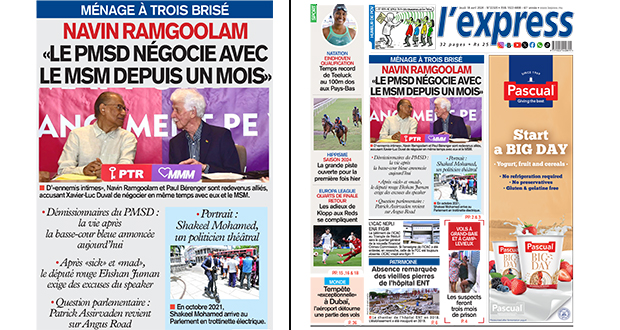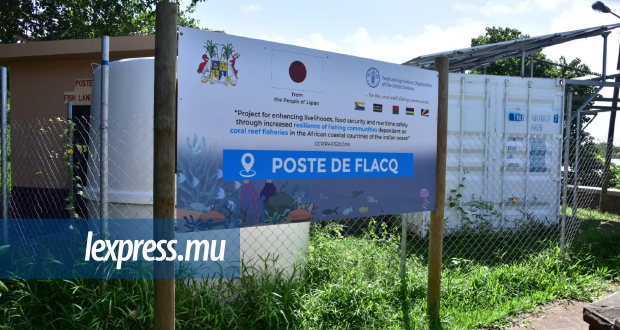Publicité
Commission Britam: En passant à la loupe le rapport
Par
Partager cet article
Commission Britam: En passant à la loupe le rapport

J’avais d’abord remarqué, ici ou là, des remarques que j’avais trouvé désobligeantes pour le président et un de ses assesseurs (distributeur de gato piment ou de pistaches, nominé de sales besognes, honoraires exorbitants, etc.). J’ai donc voulu en avoir le coeur net en entrant dans le détail du rapport lui-même (352p, 1 550 articles).
Séduit jusqu’au chapitre 4 (disons la phase préliminaire du rapport où le juge fait son baron de la Brede «en posant ses premiers principes et voir tout ce qu’il cherchait venir à lui»), j’avais déjà reproché à quelques journalistes leur excès et leur manque de retenue. Mais comme je n’étais pas encore au vif du sujet, j’ai continué.
Arrivé aux chapitres 8 et 9, les deux plus longs chapitres (92\465 et 159\159 pages\paragraphes respectivement), je suis tombé des nues. Tous les préliminaires jusqu’au chapitre 4 (que j’avais admiré) s’évaporaient comme des bondieuseries et j’avais l’impression de lire un canular à la Jean-Baptiste Bothul – 1896-1947 dont le célèbre La Vie sexuelle d’Emmanuel Kant fait encore tinter les oreilles de quelques philosophes de plateau télé. Le juge s’était éloigné lui-même de ses premiers principes, semblant naviguer sans boussole mais avec un bel entêtement sur un sujet dont il se devait d’éclaircir les tenants et les aboutissants mais dont il brouillait sciemment les cartes.
Jugeons sur pièce
Première étape, chapitre 8
(je passe à l’anglais comme dans le rapport) :
1. Key issue seems to me the terms of MMI offer: Rs4.3bn value, based on price of the 24% shares held at date D, plus 50% premium. The details of such offer (mentioned 195 times in the report) have not been tabled by the Britam report and one wonders if this offer, in fact, can be
• tabled considering its confidentiality between two parties,
• used when discussing with another party, as seems to have been the case.
Note: the buyer has an interest to stick to the share price at date D [subject to 2 (i) & 2(ii) below], whilst the seller has an interest to stick to the offer value.
2. Date D dilemma.
(i) Either it simply refers to a fixed date in the past (on or around the date of the initial offer, let’s say date X) in which case it’s the value (Rs4.3bn in our case) which is the key element,
(ii) Or it refers to a date Y (in the future) at which
(a) the share value of Britam on the NSE will be updated,
(b) such updated valuation be used to arrive at the value of the offer,
(c) both parties will reconfirm their endorsement of the deal at such price.
Note: (c) is important as we can have either of two situations – one in which the share price has gone up and the buyer is unwilling to meet the new higher value, the other in which the share price has gone down and the seller is unwilling to accept the new lower value.
In either case, the risks to the two parties are then clear.
• In (i), both parties are certain of the risk they take,
• In (ii) both parties are uncertain of the risk they take, and have an option to pull out if the value is, let’s say, lower than 80% of initial value envisaged (seller then using his opt-out option which should have been included in the offer) or more than 120% of initial value envisaged (buyer then using his opt-out option).
3. In our affair, it seems to me that in the 18th November meeting in Nairobi,
• the Mauritian (in Nairobi to attend a livestock seminar) is happy to consider offer at Rs4.3bn (i.e. with X as the date on or around the date of the initial offer), with such Rs4.3bn quoted at §2 (of discussion as minuted), i.e. at date X.
• the Kenyan party, whilst accepting §2 (of discussion as minuted), i.e. at date X, either willing (in § 4 of Discussion as minuted) to buy the shares at the same valuation as MMI has offered (minutes 1 of Lutchmeeparsad) at day Y or buy the shares at a mutually accepted valuation (minutes 2 of BDO).
• The drafting of the minutes was a blunder [as it did not elaborate of date D, with mention of Rs4.3bn value (ONLY IF D = X) and without mentioning (a) the other option (date Y), which would materially affect the final value, (b) the opt-out options for each party].
• Subsequent tampering with the minutes was a blunder if version 1 was already referring, in § 4, to a date Y as in 2 (ii), with the Rs4.3bn only a reference figure at a date X.
4. PS Luchmeeparsad (in Nairobi, let us recall, to attend a livestock seminar and, as a side dish – and an opportunity for dinner – to meet Britam) and SAJ disclosed version 1 to Commission but it is possible that they both focused only on the referential value of this version 1 and were thus both misled on their assumption that Rs4.3bn was at stake.
5. Full publication of MMI offer thus vital to clear matter. With, possibly,
• even the TOR of the commission then misleading – as considering date X as the date D to arrive at a value of Rs 4.3bn,
• all “suspect” witnesses completely missing the point when deposing in front of commission.
Deuxième étape, chapitre 9
1. Date of acceptance MMI offer mentioned (in § 199 of report) as being Sep 2015 (with no precise date for the acceptance and the date of offer itself, later a key to establish date X as per step 1 above and share price at this date X).
2. basis of share valuation mentioned (in § 333, from Yacoob Ramtoola’s deposition) as being (according to YB’s recollection – according to him) “MUR4.3bn based on the prevailing share price of Britam on the NSE which was then Kes26.90, including a premium of 50%”. In my mind,
• the Commission should have requested, prior to start of depositions, the full report itself,
• YB should have mentioned (in his first hearing of 21st June 2017 or in his subsequent 2nd to 4th hearings) the date of the MMI offer, a table of Britam’s share price between date of MMI offer and 15th November 2015 and tabled the offer (with details of its basis).
If this had been done, then the commission WOULD NOT have been in a position to report the derogatory according to him above.
As will be seen (in point 2.1 of my conclusion below),
• there is such a date (disclosed by the report itself!), but
• the report does not register its implications for its erroneous conclusions.
But let’ go first, step by step, to the other instances when MMI conditions were mentioned.
3. § 341 (from Yacoob Ramtoola’s 1st deposition) also refers to the terms above (§333), with the foll. additions:
• Offer was non binding,
• YR refers to a meeting on 14th Oct with RB where he was in presence of an MMI letter, as supplied to him by RB. Again date of above offer not mentioned.
4. § 342 (from Yacoob Ramtoola’s 1st deposition) then refers to an MMI request (on 6th Nov 2012 to FS) for extension to Feb 2016 to table a binding offer. Again letter should, in my mind, have been tabled then.
5. §353 (from Yacoob Ramtoola’s 1st deposition) then refers, in its sub par (4), to an exclusivity period of 6 months for MMI – which I assume was in the original MMI offer – and in sub par (5) to a request (on 6th Nov 2015) from MMI (to FS again, latter forwarding it to YR) to extend the deadline for submission of binding offer.
6. From then on, eg §353 (18), only Rs4.3bn mentioned, the rest of the terms of the MMI offer gardé sous le tapis by the commission. Even if YR, in §360 & §361 (2nd hearing?), re-explained the base of the value. With § 361 referring to “its letter” (presumably MMI?) and quoting from this letter (when it then becomes evident that its letter was referring to a YR’s letter).
7. §441 (Vishnu Lutchmeenaraidoo’s deposition of 27 July 2017) does elaborate on the base of the valuation (matching those of §333 – above point 2).
Subsequently, once the Kenyans advised that they wanted the sale to stay Kenyan, only Rs4.3bn is kept, with the base of such Rs4.3bn not referred to (as if had never existed). This is the case for
• The Luchmeeparsad episode who acts as if only the Rs4.3bn mattered,
• Sandeep Khapre’s minutes even if he refers to other conditions,
• Dev Manraj in his hearing of 6 September 2017 (§515 to 524),
• A Deerpalsing in his hearing of 6 September 2017 (§532), even if AD mentions “certain conditions”. And AD is mistaken (in §535) in his pricing of the share [@ 14.8Kshs at the time of MMI offer (YR was closer to the mark in § 333 \ point 2 above @ Kes26.90) and 11.75 kshs at the time of the sale].
My view: The commission strangely didn’t then put 2 and 2 together and went along with 22!
What is otherwise outrageous is that the commission,
1. in its conclusion of chapter 8 (facts from depositions), there is NO overall summary § to cover ALL the facts that can be deducted from the depositions, with facts that can be deducted ONLY MADE after EACH hearing.
2. in its conclusion of chapter 9 (facts from documents), there IS an overall summary, §939 – in 26 points – (to cover all the facts that can be deducted from the documents), of which
2.1. § 939 (2) states “MMI Holdings offered on 17 April 2015 to buy the assets at MUR4.5bn based on the then current Britam share price” ie ONLY THEN acknowledging the date of the original MMI offer to the conservators of the time, but very rapidly occulting the conditions attached to such offer and subsequently only retaining the Rs4.5bn value – with such value actually Rs4.2bn and then adjusted to R4.3bn on FS’s intervention. In my mind, the withholding (non publication) of this offer of 17 April 2015 is a serious lapse and undermines the credibility of the report. And I can guess why the publication of this offer of 17 April 2015 was withheld: it would have turned to dust the accusations made!
2.2. §939 (19) states, maliciously that “When the graph of the prices on the stock market in Nairobi with reference to the relevant dates are read, this was what it revealed: that the prices around November 2015 and June 2016 were comparable.” My view: The only honest comparison would have been between April 2015, Nov 2015 and June 2016. Comparing only Nov 2015 to June 2016 is either stupid, misleading or intended to mislead!.
2.3.§939 (22) states, maliciously again, that “the share prices at those two operative dates (18-Nov 2015 and mid- March 2016) for the transaction had remained more or less the same”. My view: erroneous comparison on a time frame that suits the author of the report (but that does not cover the relevant time frame from April 2015).
My ultimate conclusions
• The report is biased as its consistency of method (which it outlined rigorously in chapters 2, 3 and 4), wavers if not wobbles in its presentation of facts and in its different summing up at the end of chapter 8 and at the end of chapter 9.
• The report is biased and not qualified to raise penal matters (as done in subsequent chapters) on the basis of its “facts” which are not only selective but blatantly biased, despite its initial claims to impartiality.
• Je reproche à mon ami Sattar de n’avoir pas mieux expliqué au juge un domaine dont il (le juge) visiblement n’avait aucune compétence et de l’avoir laissé s’embourber – je n’ose imaginer qu’il l’ait fait sur ordre ou sur commande.
• Je connais DCDM depuis longtemps. Depuis mes premières leçons de comptabilité il y a 50 ans avec Guy Marot, un de ses fondateurs, avec ses doigts déjà handicapés par une sévère arthrite (lui permettant à peine de tenir son stylo), mais qui m’avait alors appris une chose (ce dont je le remercie ici) : l’intégrité dans les affaires et dans la vie. Je ne peux croire que BDO, qui succéda à DCDM (et encore récemment sous la férule de Jean Marc Harel) ait pu descendre dans les bas-fonds où le juge jette aujourd’hui plusieurs de ses partenaires et je suis sûr qu’ils remettront bientôt les pendules à l’heure.
• Quant aux élucubrations et aux affabulations de politiciens et de journalistes, dont le juge a fait écho, je l’en remercie – mais, heureusement, il n’y a pas que cela en politique et dans la presse.
Publicité
Les plus récents






